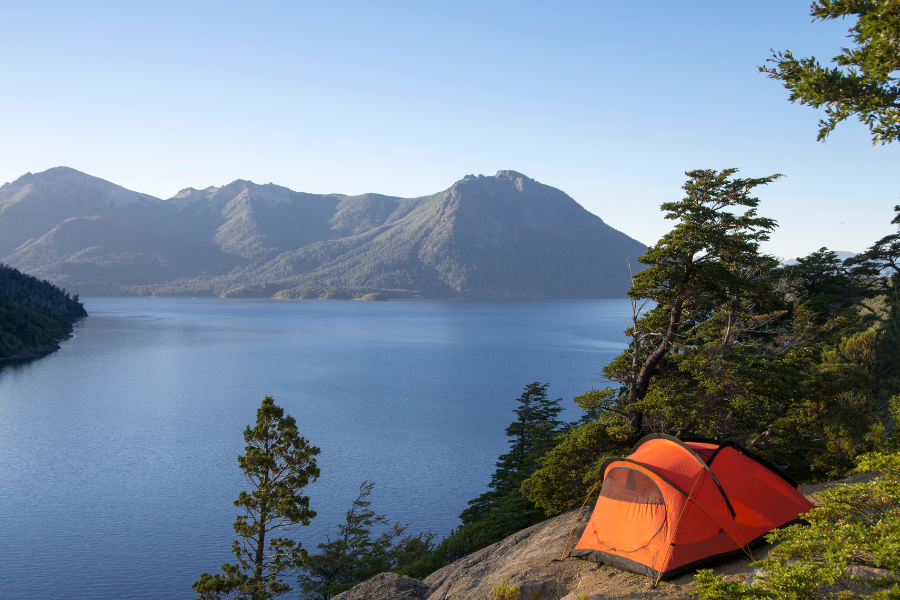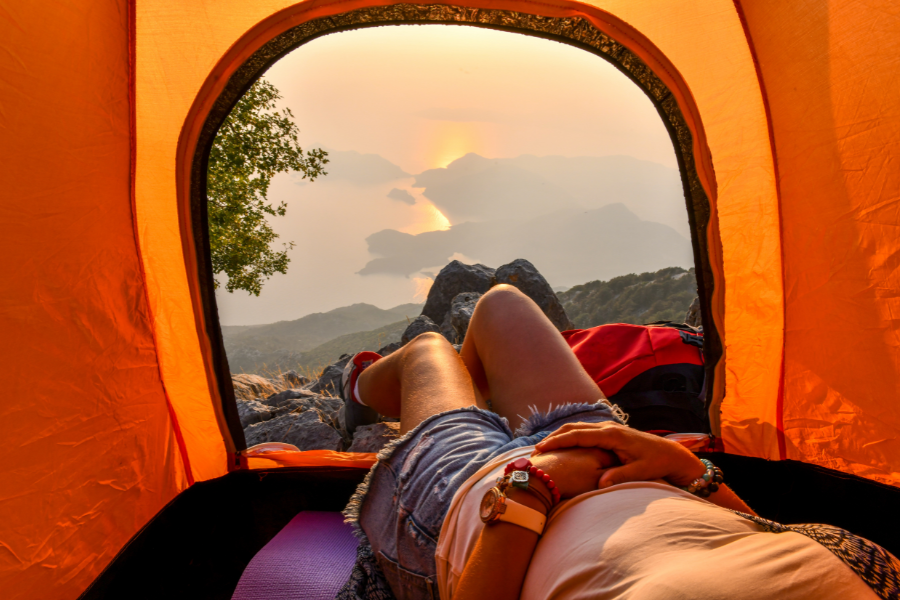Camping Unleashed: Base Camp to Mini-Camp Hiking Adventures
Sometimes Camping is my end goal. But more often than not, I like a little hiking adventure and camping as my accommodation to explore the outdoors. I love to go exploring, forest bathe, and find little moments of magic by adding hiking to my camping adventures. The moment that you get a lookout spot with a breathtaking view, a swim in a lake with no one around, or an amazing picnic spot to have lunch makes the whole experience more magical. When doing research for this article, I found that according to the Outdoor Industry Association in 2018, 49.2% of campers participated in hiking.
Here’s my guide on how to set up a base campsite, explore hiking trails, and extend your adventure with mini campsites.
A. Day Hiking Safety and Security Tips

The Joys of Day Hiking
Day hiking is a fantastic way to explore nature’s wonders while also benefiting from healthy physical activity. Here are some of the many reasons why you might want to lace up your hiking boots and hit the trails:
- Physical fitness: Hiking is a superb way to improve your physical health, offering cardio exercise that benefits your heart, a low-impact workout that can improve your strength and balance, and an endurance activity that can boost your stamina.
- Mental well-being: The tranquility of nature can be a natural stress reliever. Hiking can boost your mood, help clear your mind, and even inspire creativity.
- Accessible adventure: Day hiking can be as challenging or as leisurely as you want. Whether you’re a seasoned adventurer or a beginner, you can find a trail that suits your skill level and desired intensity.
Discovering Natural Wonders and Scenic Destinations
One of the significant appeals of day hiking is the opportunity it affords to discover new and beautiful places. Venturing on foot can lead you to locations inaccessible by any other means, unveiling a whole world of natural beauty.
- Hidden gems: You might stumble upon a hidden waterfall tucked away off the beaten path, a serene swimming hole perfect for a refreshing dip, or a meadow brimming with wildflowers. These unique spots, often missed by the casual visitor, can create some of the most memorable experiences.
- Scenic lookouts: There’s nothing quite like the sense of achievement you get when you reach a lookout point that offers panoramic views of the surrounding landscapes. Whether it’s a vista of rolling hills, sprawling forests, or majestic mountains, these moments make every step of the hike worth it.
- Wildlife encounters: Hiking can also bring you closer to nature’s inhabitants. Sightings of local wildlife like deer, birds, or even more elusive creatures can add an exciting twist to your hike.
Day Hiking Safety
When exploring the trails, always have a detailed map and a compass. Stay on marked trails to minimize the impact on nature and reduce the risk of getting lost. Always inform someone of your plans and estimated return time. Secure your campsite by storing food properly to avoid attracting wildlife.
B. Benefits of Overnight Hiking and Mini Campsites

Embarking on an overnight hiking trip and setting up a mini campsite can open up a wealth of unique experiences. Here are some compelling reasons why you might consider this kind of adventure:
- Secluded destinations: An extended hike can take you to more remote, less traveled locations. These spots often offer serene natural beauty that’s free from the hustle and bustle of popular tourist trails.
- Challenging climbs: If you’re looking to challenge yourself with a particular climb, a two-day hike allows you to break up the journey, making it more manageable and enjoyable. This way, you won’t have to rush your climb and can take the time to truly appreciate the journey.
- Mountain sunrises: There’s something magical about waking up in the wild to the first light of dawn illuminating the mountain peaks. It’s a breathtaking view that’s worth an overnight stay. Just remember, for safety, choose a location that isn’t too high in elevation to avoid the risk of altitude sickness.
C. Your Mini Guide to Hiking and Setting up an Overnight Mini-Campsite
1. Keep Your Base Camp Secure
When you venture away from your base camp to explore or set up a mini-camp, keeping your main campsite safe and secure is vital. Start by ensuring your tent is closed and secured against any potential weather changes. Valuable items should be tucked away, not visible from the outside.
Food should be properly stored to avoid attracting wildlife. In areas with bears or other large animals, use bear-resistant containers or hang your food, toiletries, and trash at least 10 feet off the ground and 4 feet from a tree trunk. This is often referred to as a “bear hang.”
Remove any trash regularly and keep the area clean. A neat and tidy campsite is less likely to attract wildlife and insects.
For added security, consider leaving a light on if you have a safe, battery-operated option, as this may deter animals and give the appearance of activity.
2. Selecting Your Mini Campsite and Ideal Distance from Base Camp
When setting up a mini campsite, choose an area that’s well-drained, sheltered, and respects local camping regulations. Also, ensure it’s a safe distance from your base camp but still within a manageable hiking distance – ideally not more than a day’s hike.
3. Essential Gear for Overnight Hiking and Minimizing Backpack Weight
You’ll need a lightweight tent or bivouac (bivy) sack, a compact sleeping bag, a headlamp, and portable cooking equipment. When packing, keep in mind that every extra ounce can make the hike more challenging, so pack light and only bring the essentials. Don’t forget food, water, small fire starter kit, and a first aid kit which has clean water tablets just in case.
4. Safety Measures in a Remote Location
When camping in a remote location overnight, ensure you have a means of communication like a satellite phone or a personal locator beacon (I NEVER hike alone!). Be aware of your surroundings and potential wildlife in the area. Having a basic understanding of first aid is also invaluable.
5. Regulations for Setting Up a Mini Campsite
Always adhere to local camping regulations, which can vary greatly depending on the area. Some regions may require permits for overnight camping or have restrictions on where you can set up camp. Do your research beforehand.
6. Tracking Your Trail Back to Base Camp
Use a GPS device or a traditional map and compass to mark the route from your base camp to your mini campsite. This will make your return trip smoother and safer. Remember to always stay on marked trails when possible.
Returning to Base Camp
On your return, ensure you leave no trace in your mini campsite. Pack all your waste and dispose of it properly back at the base camp. Once back, check the base camp for any signs of wildlife activity, and secure your food and gear.
Final Thoughts

Whether you’re setting out from your base camp for a quick morning hike or venturing off to a mini campsite for an overnight adventure, with careful planning, the right gear, and respect for nature, you can enjoy the thrill of hiking with the comfort of camping.
So pack your gear and start your adventure!
FAQs
- What types of natural wonders can I expect to see on a day hike?
- The natural wonders you might see on a day hike can vary widely depending on the location, season, and trail. You could stumble upon beautiful waterfalls, serene swimming holes, meadows filled with wildflowers, panoramic lookout points, and even wildlife in their natural habitat.
- How can I safely enjoy swimming holes during my hike?
- Safety should always be your priority. Always check the depth and current before jumping in, watch out for underwater rocks or logs, and never swim alone. Be aware of local wildlife, and respect any signage that may limit or prohibit swimming.
- What should I do to ensure I’m respecting wildlife during my hike?
- Always observe wildlife from a distance, and avoid feeding or touching animals. Stay on designated trails to minimize disruption to local fauna. Remember, you are a visitor in their home.
- Are there certain tools or resources to help me find scenic lookouts or other points of interest on my hiking route?
- Many hiking maps and apps will highlight points of interest, including scenic lookouts. Additionally, guide books, local tourism websites, or the park’s visitor center can also provide information on these points.
- What are some tips for spotting and identifying local wildlife on my hike?
- Move quietly and keep your distance to increase your chances of spotting wildlife. Early morning and dusk are often the best times for wildlife viewing. Use binoculars to get a better look without disturbing the animals. Field guides or apps can help you identify the species you encounter.





Comments are closed.